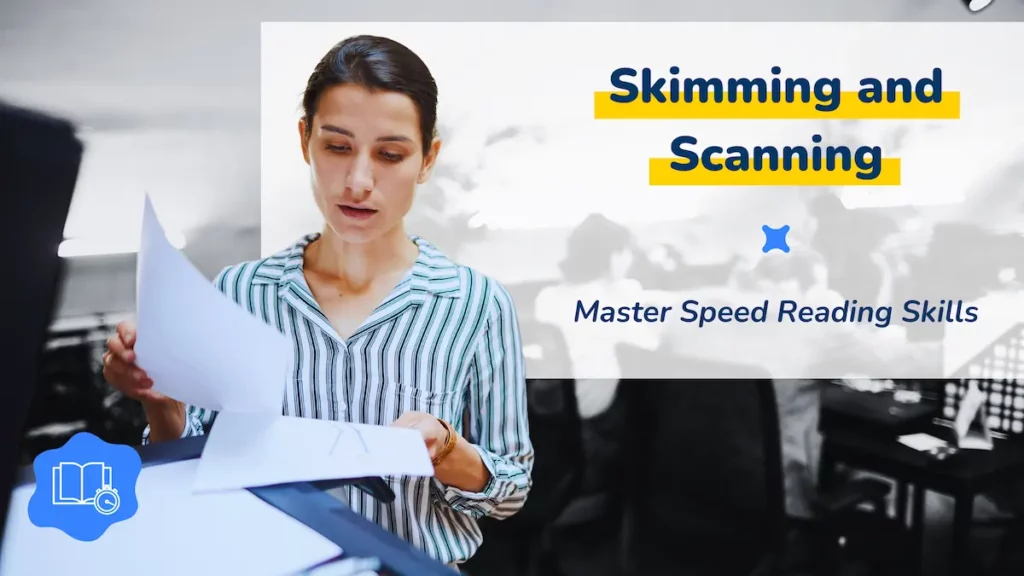Understanding Skimming
The Concept of Skimming
Skimming involves reading rapidly to get a general idea of the content. Unlike in-depth reading, where comprehension is key, skimming focuses on creating a mental snapshot of the text. Think of it as watching a movie trailer to get a sense of the plot without diving into the details.
Your initial reaction might be to read each word meticulously. However, skimming requires you to visualise your eyes as a camera capturing multiple snapshots of the text, rather than pausing to process each word individually. The objective is to move quickly, aiming for a speed of about 1,000 words per minute (WPM) or more. Your eye movements can follow various patterns, such as diagonal, S-shaped, or even random, depending on the text and your preference.
For instance, when skimming an article, reading the first and last sentence of each paragraph can provide a sufficient overview. On other occasions, following a structured pattern like moving diagonally across the page can help maintain a rhythm, allowing your eyes to move fluidly without overthinking the process.
Enhancing Your Skimming Ability
Improving your skimming skills is akin to training your brain to photograph and retain words more efficiently. One effective method is using speed-reading apps like Spreeder, which present words at a pace that encourages you to move beyond subvocalisation (silently pronouncing words) while still grasping the overall meaning.
Practice is essential to mastering skimming. Regularly challenge yourself with different types of texts, from emails to lengthy articles, and experiment with various eye movement patterns. Over time, you’ll notice a significant improvement in your ability to grasp the gist of a text quickly, which is particularly useful when a detailed reading isn’t necessary.
Mastering Scanning
The Purpose of Scanning
Scanning is another rapid reading technique, but unlike skimming, it’s used to locate specific information within a text. This method is ideal when you have particular questions to answer, need to verify details, or are searching for a specific term in a document.
When scanning, clarity on what you’re looking for is crucial. Whether it’s a keyword, date, or a specific fact, having a clear target helps your eyes quickly identify the relevant information. Your eyes naturally have the ability to locate what they seek, making scanning an efficient way to find what you need without wading through unnecessary details.
Developing Scanning Skills
To enhance your scanning proficiency, you can practice with targeted exercises. Start by taking a page of text and asking someone to give you a set of three words to find. Your task is to locate these words as swiftly as possible. Initially, work with easily recognisable items like numbers, capitalised words, or unique names. As you improve, challenge yourself with more subtle information in plainer text and smaller fonts.
If you don’t have a partner to assist, create your own practice materials. Copy a page of text, cut it into pieces containing two to three words each, shuffle them, and practise locating words from these fragments. This self-directed exercise can significantly boost your scanning skills, allowing you to become more autonomous in your practice.
Practical Applications of Skimming and Scanning
Efficient Email Management
In the modern world, managing emails efficiently is a crucial skill. Skimming helps you quickly assess the relevance of each email. By reading the first and last sentences or following a quick diagonal pattern, you can determine if the email warrants a more thorough read. Scanning, on the other hand, allows you to pinpoint specific details, such as dates, times, or key points, enabling you to respond promptly without reading the entire email.
Research and Information Gathering
When conducting research, skimming and scanning can save you valuable time. Skim through academic papers or articles to get an overview of the content and decide if they are worth a deeper dive. Use scanning to locate specific information, references, or data points. This dual approach enhances your efficiency, allowing you to cover more ground in less time.
Academic and Professional Reading
For students and professionals, skimming and scanning are indispensable. These techniques help you navigate through textbooks, reports, and professional documents with ease. Skim to understand the structure and main ideas. And then scan for specific information required for assignments, projects, or presentations. This not only improves your productivity but also helps in managing large volumes of information effectively.
FAQs About Skimming and Scanning
What is the main difference between skimming and scanning?
Skimming involves quickly reading through text to grasp the general idea, while scanning focuses on locating specific information within the text.
Can skimming and scanning improve my overall reading speed?
Yes, regularly practicing skimming and scanning can enhance your reading speed and efficiency, making you more adept at processing information quickly.
When should I use skimming instead of scanning?
Use skimming when you need a broad understanding of the content without focusing on details. Scanning is best when you need to find specific information quickly.
Are there any tools that can help improve my skimming and scanning skills?
Speed-reading apps like Spreeder can help you practice skimming by presenting text at a rapid pace. For scanning, creating custom exercises with target words can be very effective.
Can skimming and scanning be applied to digital texts?
Absolutely. Both techniques can be used on digital texts, such as e-books, online articles, and PDFs, making them versatile skills for various reading formats.
How can I balance skimming and scanning with deep reading?
It’s important to recognise when each technique is appropriate. Use skimming and scanning for initial reviews or locating information, and switch to deep reading for thorough comprehension when needed.
Skimming and scanning are essential skills for efficient reading, especially when your goal is not to understand everything in detail. By mastering these techniques, you can save time, quickly locate necessary information, and improve your overall reading efficiency. Whether you’re managing emails, conducting research, or navigating academic materials, skimming and scanning provide valuable tools for effective information processing.







